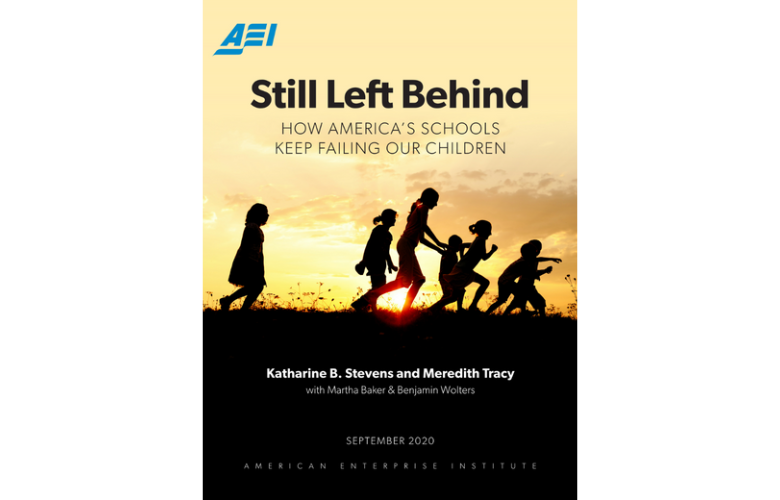Schools Aren't Everything
By Katharine B. Stevens
OP-ED
September 22, 2015
Since passage of the Elementary and Secondary Education Act in 1965, we've relied on the public schools as our primary strategy to level the playing field for disadvantaged children. For half a century the schools have failed to accomplish that goal. And for years now we've been trying to reform them with little to show for our extensive, expensive efforts.
Despite decades of increasing K-12 spending, 12th grade reading and math scores on the annual National Assessment of Educational Progress tests have not improved since they were first given over 40 years ago. While scores have risen somewhat for fourth and eighth graders, by high school those gains seem to disappear. Sixty-two percent of high school seniors score below proficient in reading. Seventy-four percent score below proficient in math. Drop-out rates are down, but 5 percent of white students, 7 percent of black students, and 12 percent of Hispanics still don't even graduate from high school. Just 5 percent of black students who took the ACT exam in 2013 were ready for college.
Now there's yet another reform idea on the table, which has been gaining a lot of steam lately: adding a pre-K grade to the public schools as "a powerful tool for improving our education system," in the words of a 2011 report released by a national coalition of leading K-12 organizations. Randi Weingarten, president of the American Federation of Teachers (one of the coalition's seven members), emphasized repeatedly at a recent event on post-Katrina New Orleans school reforms that universal pre-K will improve the nation's schools when many other solutions have failed.
Unfortunately, though, it seems very unlikely that adding another grade to the 13 already in place is the silver bullet we've long been seeking. In fact, we have pretty considerable evidence to suggest that it's not. Since 1970, the percent of 3- to 5-year-olds attending pre-primary education has increased dramatically. The number of enrolled 5-year olds grew from 69 percent to 84 percent, with those attending full-day programs jumping from 12 to 73 percent. During that same period, the number of 3- and 4-year-olds attending preschool almost tripled, growing from 21 percent in 1970 to 55 percent in 2013, and those attending full-day programs rose from 26 to 51 percent.
If preschool were the game-changer people are hoping for, the great increase in 3- to 5-year-olds attending preprimary education would have had a big impact on student achievement in later years. But it's had literally no effect on students' NAEP reading and math scores by the time they reach 12th grade.
What's going wrong? Despite years of hard work and trillions of dollars, neither preschool nor other reforms have made a difference by the time it really matters: when children finish school. In the face of this daunting reality, advocates from both the left and the right continue to argue that we just haven't done enough of whatever solution they promote. Not enough young children are in preschool. We haven't spent enough money or given teachers enough support. We haven't reduced regulation enough; we haven't given parents enough choice.
But what if schools aren't the right vehicle for what we're trying to do in the first place?
The idea that the public schools are the solution to addressing poverty and increasing opportunity for all children is a relatively new one in America's history. In 1900, only about 10 percent of children from ages 14 to 17 were even enrolled in high school. It wasn't until the 1920s that nationwide laws requiring all children to attend school were in place and enforced. By 1960 the graduation rate had reached just 70 percent.
And up to the mid-1960s, the purpose of the nation's public schools was viewed very differently than it is today. For decades, the schools aimed primarily to assimilate the great influx of immigrants and produce disciplined, capable workers and citizens. A 1951 U.S. Office of Education publication, for example, noted that "most boys and girls are headed for jobs that require little training," and encouraged schools to lower students' expectations of their career choices rather than "inspir[ing] glamorous hopes that may not be justified."
But in 1965 President Lyndon B. Johnson urged a new role for America’s public schools, proposing that they serve as the means to break the cycle of poverty and better poor children's lives. The Elementary and Secondary Education Act was passed that year, initiating decades of sharply rising education spending. And since then, virtually all hopes for helping disadvantaged children have been pinned on the public schools, even as schools' inadequacy has become an increasingly urgent concern. Today, total school spending is over $600 billion, dominating policy efforts to boost life chances for poor children. Indeed, the newest idea to improve the schools is just more school: adding a grade for 4-year-olds to the 13 grades that now exist.
School is very important. It can and should be much better than it is. But it's not the only thing that matters. Crucial brain development occurs long before children turn four. Children spend years at home and in child care long before they even enter preschool. Families and communities have a critical impact on children's lifelong well-being. If we really want to help kids, we have to pay much more attention to the other parts of their lives that also matter a great deal.
See Also
Report ~ September 21, 2020
Op-Ed ~ July 27, 2017
Podcast ~ February 16, 2022




